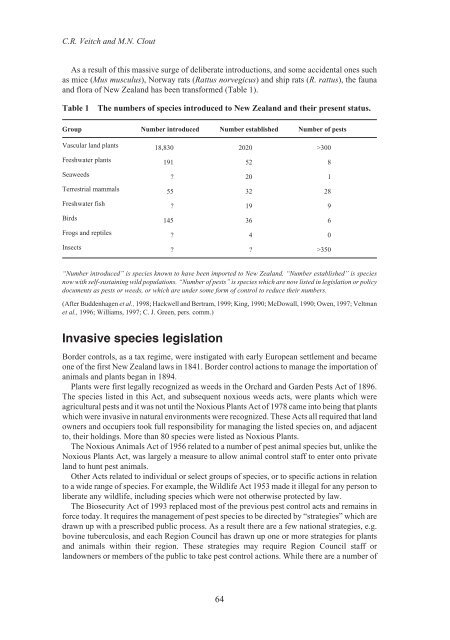Alien Species.vp - IUCN
Alien Species.vp - IUCN
Alien Species.vp - IUCN
You also want an ePaper? Increase the reach of your titles
YUMPU automatically turns print PDFs into web optimized ePapers that Google loves.
C.R. Veitch and M.N. Clout<br />
As a result of this massive surge of deliberate introductions, and some accidental ones such<br />
as mice (Mus musculus), Norway rats (Rattus norvegicus) and ship rats (R. rattus), the fauna<br />
and flora of New Zealand has been transformed (Table 1).<br />
Table 1 The numbers of species introduced to New Zealand and their present status.<br />
Group Number introduced Number established Number of pests<br />
Vascular land plants 18,830 2020 >300<br />
Freshwater plants 191 52 8<br />
Seaweeds ? 20 1<br />
Terrestrial mammals 55 32 28<br />
Freshwater fish ? 19 9<br />
Birds 145 36 6<br />
Frogs and reptiles ? 4 0<br />
Insects ? ? >350<br />
“Number introduced” is species known to have been imported to New Zealand. “Number established” is species<br />
now with self-sustaining wild populations. “Number of pests” is species which are now listed in legislation or policy<br />
documents as pests or weeds, or which are under some form of control to reduce their numbers.<br />
(After Buddenhagen et al., 1998; Hackwell and Bertram, 1999; King, 1990; McDowall, 1990; Owen, 1997; Veltman<br />
et al., 1996; Williams, 1997; C. J. Green, pers. comm.)<br />
Invasive species legislation<br />
Border controls, as a tax regime, were instigated with early European settlement and became<br />
one of the first New Zealand laws in 1841. Border control actions to manage the importation of<br />
animals and plants began in 1894.<br />
Plants were first legally recognized as weeds in the Orchard and Garden Pests Act of 1896.<br />
The species listed in this Act, and subsequent noxious weeds acts, were plants which were<br />
agricultural pests and it was not until the Noxious Plants Act of 1978 came into being that plants<br />
which were invasive in natural environments were recognized. These Acts all required that land<br />
owners and occupiers took full responsibility for managing the listed species on, and adjacent<br />
to, their holdings. More than 80 species were listed as Noxious Plants.<br />
The Noxious Animals Act of 1956 related to a number of pest animal species but, unlike the<br />
Noxious Plants Act, was largely a measure to allow animal control staff to enter onto private<br />
land to hunt pest animals.<br />
Other Acts related to individual or select groups of species, or to specific actions in relation<br />
to a wide range of species. For example, the Wildlife Act 1953 made it illegal for any person to<br />
liberate any wildlife, including species which were not otherwise protected by law.<br />
The Biosecurity Act of 1993 replaced most of the previous pest control acts and remains in<br />
force today. It requires the management of pest species to be directed by “strategies” which are<br />
drawn up with a prescribed public process. As a result there are a few national strategies, e.g.<br />
bovine tuberculosis, and each Region Council has drawn up one or more strategies for plants<br />
and animals within their region. These strategies may require Region Council staff or<br />
landowners or members of the public to take pest control actions. While there are a number of<br />
64












